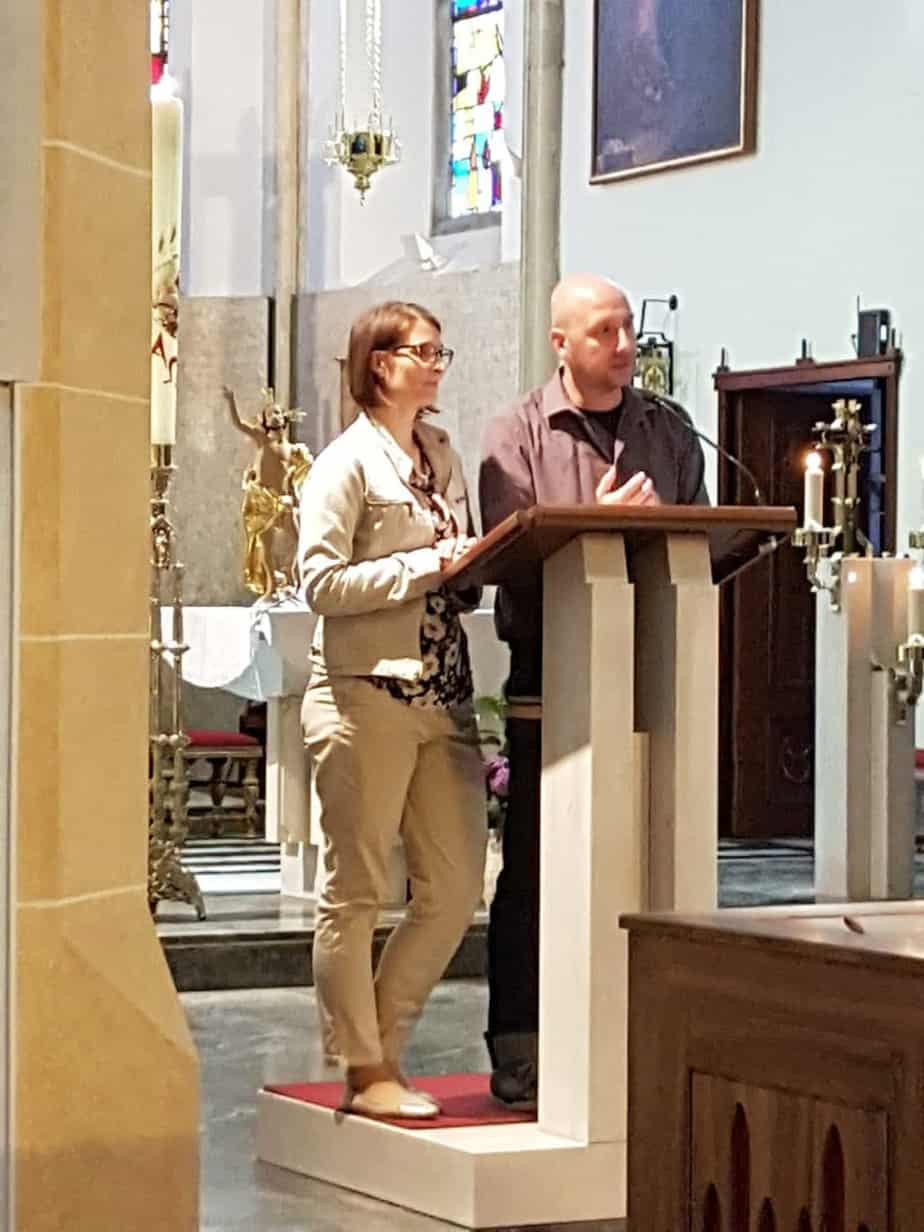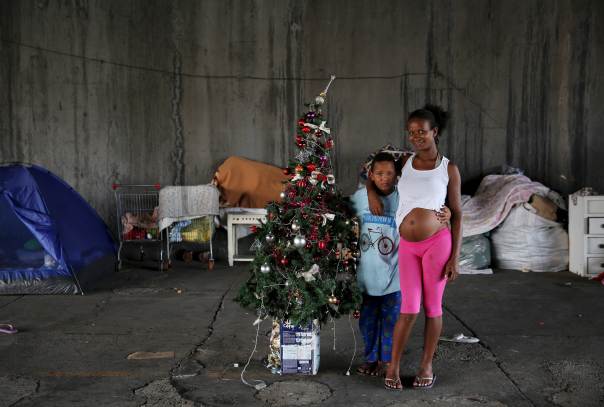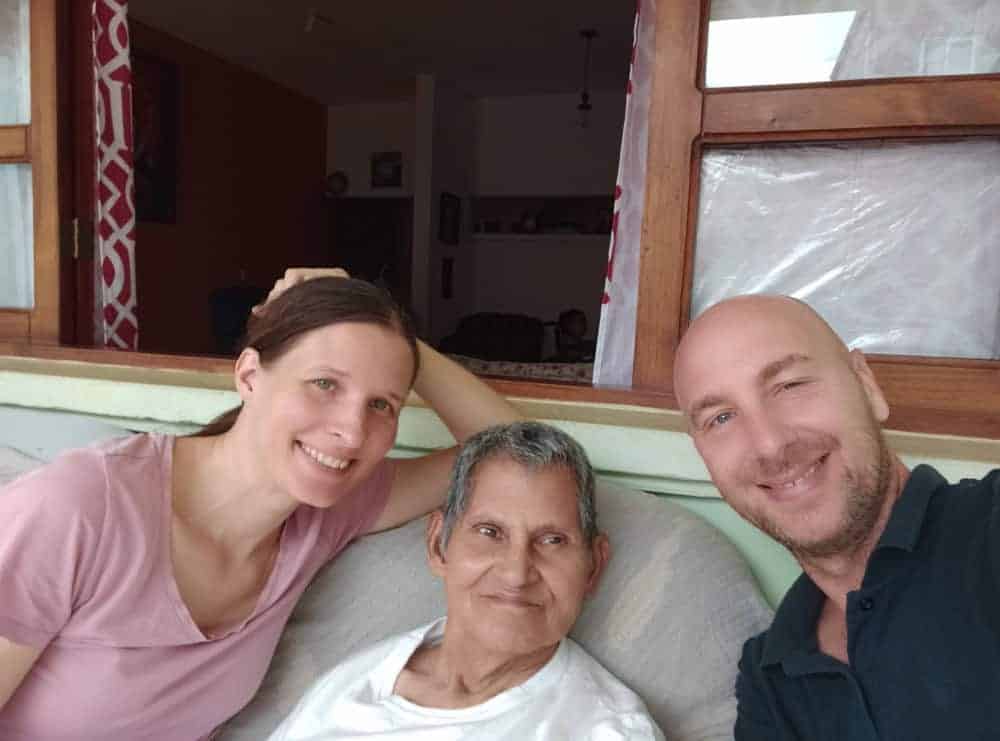
We stayed almost three months in Slovenia. Much longer than we initially planned. But it was worth it. Not only because we relaxed well after a one-year trip through Asia, but also because we have had great opportunities to promote Operando and our path during this time. Testimony sharing is one of the main missions of our society. Our mission.
The message is spreading
We are really grateful that people appreciate and support our work. Also the media and not only the Christian media. Slovenian newspaper NeDelo and Zarja magazine published an extensive interview about our missionary work.
The word about the good people we meet on the road and the word about the charity projects aimed at people from the edge of society deserve to be heard. People must get to know there is still a lot of good on our planet.
Testimony sharing in Kranj (Slovenia)
Our last testimony share in Slovenia was in our home town Kranj at the evening Holy mass at the St. Cantius church in Kranj.

It was a magical missionary event to which the Šambača vocal group added some color notes with Christian songs from around the world, chosen specifically for this event.
Back on the road
Goodbye our homeland Slovenia, hello Brazil. We are only halfway through our path and this year we are dedicating it to South America. After a long flight across the ocean we landed in São Paulo, Brazil.
São Paulo is Brazil’s largest city and also the largest city in the entire territory of South America, with nearly 18 million citizens. The entire province of Sao Paulo, which also includes other major cities in the region, counts about 40 million people.
Two million
We are already used to smiley faces, when we tell people there are 2 million people living in the entire Slovenia. In São Paulo, there are 2 million people living in barrack settlements only! A mid-size Brazilian city would have 2 million citizens.
São Paulo was founded by the Jesuits on January 25, 1554. It lies on the hilly part of Brazil, 820 meters above the sea level. Due to the high altitude, average temperatures are somewhat lower than in other Brazilian cities.
Since it lies in the southern latitude, the seasons are just the opposite compared to the northern hemisphere (Slovenia). Even though winter is coming, temperatures never get below 20 degrees Celsius.
Looks Are Deceiving
Judging only by the numbers, Sao Paulo is not only the richest city in Brazil, but in the entire South America. It’s the nation’s business and cultural metropolis, producing 10% of Brazil’s GDP.

Sao Paulo ranks third in the world by the number of modern skyscrapers – there are hundreds of high-rise and office buildings. Wealthy residents prefer helicopters to cars in order to avoid traffic jams.
With 2000 such flights per day, the city ranks at the top of the list. Huge shopping centers and modern cars also play a role in obscuring the reality.
However, the numbers don’t show the whole picture. The city can quite easily mislead any foreigner.
Gloomy Contrast
Much like Brazil as a whole, Sao Paulo, too, is gripped by a large gap between the rich and the poor and extreme poverty, which has become particularly evident in recent years due to the economic (and political) crisis.

In fact, tens of millions of Brazilians live below the poverty threshold. These people represent almost a quarter of Sao Paulo’s population. Unemployment is on the rise, and even people with jobs suffer from poor living conditions.
Ruined Lives
One of Brazil’s biggest problems is poorly planned and half-baked urbanization – building the infrastructure on the plots of land where people developed good living conditions through the years.
The government simply assesses that the land is suitable for infrastructure and begins building factories, roads, power plants and other infrastructure, disregarding the will of the people.
Consequently, there is a drop in land prices and the quality of life, and people start to move to bigger cities, seeking better living conditions in the hope of a brighter future, however…
Homeless, Jobless
…all too often, the door is shut. Jobs are sparse, so many residents remain unemployed and later become homeless. This is a common sight in Sao Paulo – people under the bridges, at the bus stops, railway stations, on the sides of the roads…

This is the story of thousands of people who moved – and still move – to Sao Paulo. They now live in poverty alongside those who came before.
Before the breakdown
A foreigner might get a feeling that he is in a blossoming modern world but in reality, the city is on a verge of a breakdown, according to experts.
Inequality is appalling, and a great deal of the population is at the margins of society. Paradoxically, economic power enables continuous growth and development that make the problems even bigger: pollution, floods, lack of security, bad transport system and overcrowded roads. A vicious circle that will be hard to break.
We landed in Brasil that’s facing historical crisis and numerous challenges.
At the airport in Sao Paolo we were met by misionary Lucas and mr. Cardoso who is an active member of the parish.
We had an hour-and-a-half drive ahead of us to the Hortolandia town where a group of Ksaverians lives.
City of gardens
There are 18.000 people living in Hortolandia (city of gardens) which is situated at the entrance to a much larger city of Campinas with more than one million inhabitants.

This is a fairly new city aged 25 years. People started moving here from all over Brasile due to the mentioned urbanization. Those are mostly poor people who abandoned their land and went to Sao Paolo to seek better life. Many of them are still “searching”.
At the Ksaverians
The Xaverians are a missionary community that draw their inspiration from the famous Jesuit missionary Francis Xavier. I’ll write more about the community in my next post.

A house where three fathers live, Giovanni, Alfiero (both Italian aged 80) and Lucas, a young Bengali, is nice and renovated three years ago.
But the community is not only a mission where missionaries perform various activities for poor people of the town, but also a novitiate where future missionaries are being formated. They haven’t received any novice this year yet but there were at least ten of them in the past years.
The fathers prepared a nice room and set up everything else for us to be settled and start the work that awaits us.
Nace Volčič



